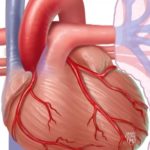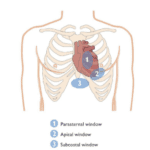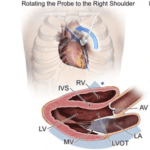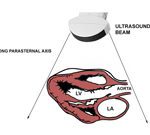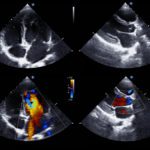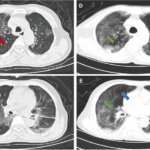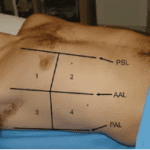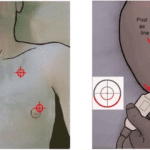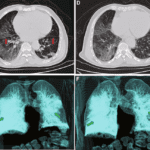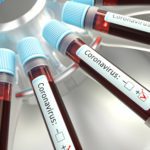Healthy heart function is a key component of the body’s survival. When something goes wrong, healthcare practitioners don’t usually have much time to determine the cause to inform an appropriate treatment plan. The ability to investigate quickly and non-invasively allows providers to diagnose acute situations accurately. Point-of-care ultrasound (POCUS) technology provides:
- Imaging that can show blood flow irregularities.
- Organ changes.
- Blood clots.
- Damage in the heart, veins, and other vital organs.
The SESAME-Protocol
The SESAME-protocol is a holistic approach used to systematically screen the body to determine the mechanism and cause of the cardiac event. It consists of 5 simple steps performed using the same probe to avoid delay. The outlined steps are used to quickly rule out any reversible cause of cardiac arrest.
Step 1. The first scan is of the lungs to rule out pneumothorax. It is performed first because it can be completed in two seconds and pneumothorax with cardiac arrest is usually large and can be detected wherever the probe is applied.
Step 2. Scan the lower femoral vein at the V-point to detect deep venous thrombosis (DVT), which diagnoses pulmonary embolism. If there is no visible clot or the vein is incompressible, DVT may not be likely, and the exam can move on.
Step 3. The abdominal cavity is then checked for fluid accumulation. This assessment will be quick, focusing on finding large fluid pockets avoids being bogged down in a deeper evaluation for the sake of speed..
Step 4. Next, the pericardium is scanned. A substantial pericardial effusion can indicate tamponade with obstructive shock. If detected, the treatment needle can be guided by POCUS immediately.
Step 5. A few seconds may be needed to change the depth on the scanner before moving to the heart, but it is not absolutely necessary to change the probe. The technician looks for asystole, dilated right ventricle, which could mean pulmonary embolism, a dilated right ventricle, or collapsed right cavities, indicating tamponade. Steps one and three have partially ruled out hypovolemia, but the left ventricle can be inspected for hypercontractility.
The SESAME-protocol can be performed in less than one minute by practiced technicians. POCUS is not only a diagnostic tool but used to support treatments. If chest compressions have begun before the ultrasound application, they must be interrupted to perform the lung examination. The clinician must assess the risk factor and move the probe quickly.
Pre-Hospital Setting
In pre-hospital services, POCUS in cardiac arrest protocols has increasing value. It has been identified as a method to locate a pulse in a cardiac arrest victim faster and deemed more reliable than a manual pulse check. POCUS can also be used to detect the absence of cardiac activity and guide decision-making regarding termination of resuscitation.
POCUS is useful in determining reversible causes of cardiac arrest during emergency services. It is instrumental in identifying the difference between PEA and pseudo-PEA, preventing harm from standard cardiac arrest treatments not indicated for pseudo-PEA. POCUS will detect the cardiac activity not found during a manual pulse check.
With proper training, POCUS has the potential to provide increasingly beneficial results when included in cardiac arrest protocol. With each specific clinical situation, the practitioner can adjust quickly based on findings and be instrumental in guiding treatment. Using the SESAME-protocol, POCUS can provide a real-time picture of the state of the heart.
Let’s celebrate American Heart Month with the image of heart health by increasing the number of technicians trained in POCUS cardiac arrest protocol, keeping hearts beating.

